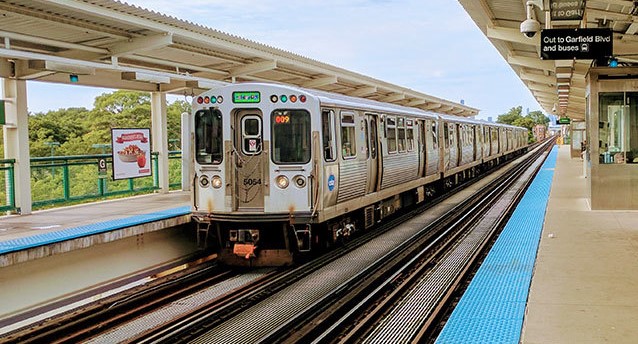The COVID-19 pandemic has changed a lot of what we perceive and know about mobility and transportation.
In recent months, Active Trans met with more than 100 stakeholders who are invested in our work. We spoke with community partners, elected officials, department of transportation and transit agency officials, and residents across the city and suburbs.
As part of this process, we held a series of small-group conversations and solo conversations with stakeholders and an elected official on the city’s West Side. Though not all-encompassing, here’s a glimpse of what residents on the West Side are experiencing.
TRANSIT
As changes are made to public transit to accommodate the needs of public health, one of the top concerns we heard on the West Side was the need to ensure the safety of those most marginalized, including people with disabilities and seniors.
People also expressed concerns about safety at bus stops in areas like Austin — a concern that has increased during the recent uptick in violence.
Residents and stakeholders also remarked on the following:
- The Green and Blue lines are important assets to people on the West Side of Chicago.
- CTA continuing to operate is and was significant for residents needing to get to and from work. There are, however, concerns about full buses endangering people riding the bus.
COMMUNITY SAFETY
In regards to community safety, these are some of the details that emerged from our conversations:
- In Garfield Park and Austin, public safety came up as a top concern in the midst of the pandemic. The issue of overpolicing also came up.
- In Austin, community members are organizing and working to address the recent spike of violence brought on by stressors of the pandemic.
- People we spoke with emphasized that offering youth opportunities to keep them active remains a key strategy to keep communities on the West Side safe.
ACCESS TO WALKING AND RECREATION
In Garfield Park, there does not seem to be a great need for more room for walking and biking. Residents are seeing Douglas, Franklin, and Humboldt Parks being used for recreation, but overcrowding issues were not mentioned.
People pointed to a lack of bustling commercial corridors as one reason that overcrowding for people walking doesn’t seem to be an issue.
Participants also said:
- Increased speeding is a problem because traffic patterns have changed due to the pandemic.
- People want to see potholes fixed, sidewalks repaired, and more handicap accessible spaces created.
- One of our participants mentioned the potential of groups in Garfield Park and North Lawndale partnering to ensure streets are repaired near the Blue Line transit stops on the West Side.
BIKING
On the subject of biking, we heard about the many barriers people on the West Side face. We also heard about the potential of biking to serve as a way to keep people healthy and active. Making the boulevards on the West Side more bike friendly was one idea mentioned for enhancing biking opportunities for residents.
Here are some other details that emerged in our meetings:
- While there is a desire for more opportunities for safe recreational biking, people said the potential for encounters with police is a barrier and a concern.
- Austin and North Lawndale lack bike lanes and other types of infrastructure to make biking a realistic option for residents. In Austin, it can be “a culture shock to see people on bikes,” said one participant.
- Despite the lack of infrastructure, one participant did note an increase in biking in Austin during the pandemic.
- Gang territories are a factor in thinking about how people can use bikes to get around.
- In North Lawndale, a participant mentioned the need to repair potholes and streets in order to make it easier to bike.
To discuss biking as a form of movement for more people during the pandemic, the question of access to bikes has to be part of the conversation.
In Humboldt Park’s West Town Bikes, there has been an increase in sales and service of bikes. Despite this trend, access to bikes is an issue because the supply chains from China have been disrupted. There is also the issue of staffing at bike shops.
ACCESS TO RESOURCES
Our listening sessions were meant to help us understand mobility and transportation, but also the intersecting issues. Here are some topics that were raised in relation to issues that intersect with transportation:
- In Austin, issues of food access are ongoing, particularly as many of the small stores were affected by looting. Daycare was also cited as a major concern.
- Young people in Austin need resources to address the trauma they are experiencing.
- In Humboldt Park, access to food and access to the internet are prominent issues.
- More help for addressing homelessness is needed. One participant offered advice as to how active transportation advocates can help. He said transportation advocates can be supportive of existing efforts on the frontlines.
_________________________________________
Thank you to those who took the time to speak with us about transportation, mobility needs, and creating a vision for a more resilient future. We look forward to advocating for and implementing that vision together:
- Roberto Maldonado, 26th Ward Alderman
- Daniel La Spata, 1st Ward Alderman
- Dianne Grissett, Latino Union of Chicago
- Mike Tomas, Garfield Park Community Council
- Alex Wilson, West Town Bikes
- Rochelle Jackson, North Lawndale Community Coordinating Council
- Martin Coffer, Breakthrough
- Juan Villalobos, BUILD
- Charles Perry, West Side Health Authority
Please check out our companion blog posts that focus on Chicago’s South Side and Southwest Side.

